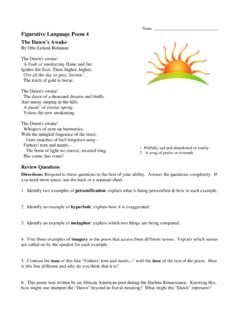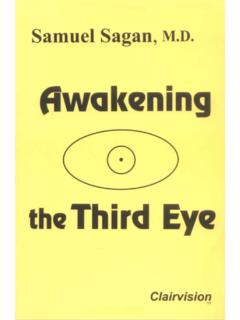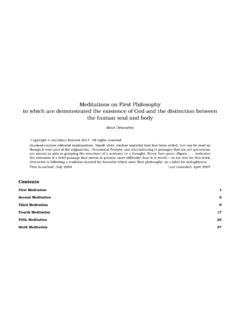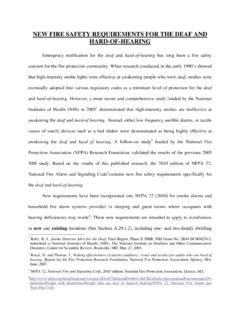Transcription of AWAKE FIBREOPTIC INTUBATION THE BASICS …
1 Sign up to receive ATOTW weekly - email AWAKE FIBREOPTIC INTUBATION THE BASICS . ANAESTHESIA TUTORIAL OF THE WEEK 201. 18TH OCTOBER 2010. Dr S Kritzinger Registrar in Anaesthetics Pinderfields General Hospital, Wakefield, UK. Dr M van Greunen Consultant Anaesthetist Leeds General Infirmary, Leeds, UK. Correspondence to SELF ASSESSMENT QUESTIONS. Before continuing, please attempt the following True/False questions. The answers can be found at the end of the article. 1. Regarding assessment of a patient's airway a. A Mallampati class III view means that the hard palate, soft palate and uvula are visible b.
2 A sternomental distance of < predicts a difficult INTUBATION c. A thyromental distance of < predicts a difficult INTUBATION d. The thyromental distance is measured with the patient's head fully flexed e. A horizontal mandibular length of >5cm suggests a good laryngoscopic view 2. The following are indications for an AWAKE FIBREOPTIC INTUBATION : a. A patient with atlanto-axial instability of their cervical spine, secondary to Rheumatoid Arthritis b. Impending airway obstruction secondary to acute epiglottitis c. A history of difficulty in mask ventilation d.
3 A predicted difficult airway in an uncooperative patient e. A patient with severe facial injuries and active intra-oral haemorrhage 3. Regarding AWAKE FIBREOPTIC INTUBATION : a. The maximum topical dose of Lignocaine for an 80kg patient is 880mg b. When a trans-tracheal injection of Lignocaine is performed to anaesthetise the subglottic region, the patient is asked to exhale prior to injection of the Lignocaine c. Trans-tracheal injection is performed between the 2nd and 3rd tracheal rings d. The fibrescope is passed along the superior nasal meatus e.
4 A white out of the view with the fibrescope is caused by secretions f. The patient can be safely extubated deep at the end of the surgery INTRODUCTION. AWAKE FIBREOPTIC INTUBATION (AFOI) is an essential skill in the management of a patient with a known difficult airway (who has previously required AFOI or other procedures and adjuncts aside from normal airway adjuncts for ventilation and INTUBATION ), or who has an anticipated difficult airway as found during the airway assessment preoperatively. AFOI is a technique which allows a flexible oral or nasal route to provide a clear visualisation of the vocal cords, and subsequent passage of an endotracheal tube into the trachea under direct vision.
5 The aim of this tutorial is to provide a basic recipe for carrying out an AWAKE FIBREOPTIC INTUBATION , safely, in a patient whom you have assessed to have a predicted difficult airway. ATOTW 201 AWAKE FIBREOPTIC INTUBATION the BASICS , 8/10/2010 Page 1 of 6. Sign up to receive ATOTW weekly - email It is important to know the anatomy of the normal upper and lower airways, from the nasal passage to the carina/bifurcation of the trachea. It is also essential to have a good knowledge of the mechanisms of action and maximum dosages of various local anaesthetic agents and vasoactive drugs, as these are used widely in this technique.
6 Recognition of the signs, symptoms and treatment of local anaesthetic toxicity is essential. Furthermore, the anaesthetist should have a management plan for dealing with any difficult airway scenario, predicted or unpredicted. Here is a brief overview and some links for the management plans of some of these scenarios. 1. The anticipated difficult airway: Without airway obstruction AFOI is the gold standard in managing this airway With airway obstruction untreated, this will lead to hypoxia and all the consequences thereof.
7 The management of this airway depends on the scenario, the site, and the severity and progression of the obstruction, as well as the expertise of the anaesthetist. Examples of this would be upper airway trauma, rapidly progressing infections of any aspects to the upper airway (acute epiglottitis, croup, tonsillar abscesses), and the all too common foreign bodies stuck in upper airways. 2. The unanticipated difficult INTUBATION airway difficulties occurring despite a normal . preoperative airway assessment: Following routine induction of anaesthesia, can't intubate, can ventilate scenario.
8 This is where the patient can still be ventilated and oxygenated by means of a face mask or other supraglottic device (laryngeal mask airway), but an inability to intubate the trachea During routine induction, where there is no risk of aspiration, and a non-depolarising neuromuscular blocking agent is used. During rapid sequence induction, where there is a risk of aspiration and Suxamethonium is used. 3. Can't intubate, can't ventilate The inability to secure the airway and inability to oxygenate the patient's lungs. DEFINITION OF THE DIFFICULT AIRWAY.
9 There are various definitions of the difficult airway . The American Society of Anaesthesiologists Task Force describes it as the clinical situation in which and anaesthetist experiences difficulty with facemask ventilation, difficulty in supraglottic device ventilation, difficulty in tracheal INTUBATION or all three. Another description of the difficult airway is, while using direct laryngoscopy >2 attempts at INTUBATION with the same or different blade Or using adjuncts to direct laryngoscopy Or using an alternative device or technique following failed INTUBATION with direct laryngoscopy Difficult laryngoscopy equates to Cormack and Lehane's Grade 3 or 4 view of the larynx.
10 Perhaps the most appropriate definition is a scenario in which safe oxygenation and ventilation of a patient cannot be achieved in the desired manner. MANAGEMENT OF THE DIFFICULT AIRWAY. Preoperative airway assessment Recognition of the difficult airway by history, examination and predictive tests (these can be found in any anaesthetic textbook). In the patient's history, look particularly for previous difficulties in mask ventilation or INTUBATION . ATOTW 201 AWAKE FIBREOPTIC INTUBATION the BASICS , 8/10/2010 Page 2 of 6.

















